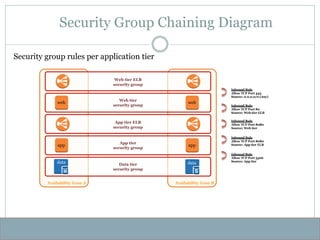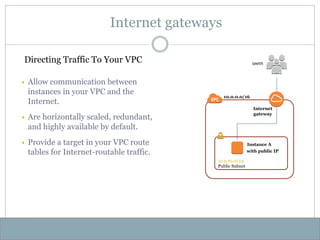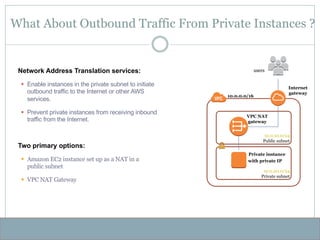AWS VPC
- 1. R I C H A R D F R I S B Y J I M M Y M C G I B N E Y Amazon Web Services – Virtual Private Cloud (VPC)
- 2. Amazon Virtual Private Cloud (VPC) — An Amazon VPC is an isolated portion of the AWS cloud. You use Amazon VPC to create a virtual network topology for your Amazon EC2 resources. — You have complete control over your virtual networking environment, including selection of your own IP address range, creation of subnets, and configuration of route tables and network gateways. — You can create a public-facing subnet for your webservers that has access to the Internet, and place your backend systems such as databases or application servers in a private-facing subnet with no Internet access
- 3. Amazon Virtual Private Cloud (VPC) § Provision a private, isolated virtual network on the AWS cloud. § Have complete control over your virtual networking environment. Amazon VPC
- 4. VPCs and subnets § A subnet defines a range of IP addresses in your VPC. § You can launch AWS resources into a subnet that you select. § A private subnet should be used for resources that won’t be accessible over the Internet. § A public subnet should be used for resources that will be accessed over the Internet. § Each subnet must reside entirely within one Availability Zone and cannot span zones.
- 5. VPC example Virtual Private Cloud AWS Cloud Public Subnet Private Subnet VPN Only Subnet DB Server Web Server Customer Network R Internet App Server VPC NAT Gateway Internet Gateway Web Server App Server DB Server Virtual Private Gateway
- 6. Security in your VPC • Security groups • Network access control lists (ACLs) • Key Pairs Subnet 10.0.1.0/24 Internet Gateway VPN Gateway VPC Router 10.0.0.0/16 Security Group Security Group Network ACL Network ACL Routing Table Routing Table instance instance instance instance Subnet 10.0.0.0/24 Security Group Security Group
- 7. VPN connections VPN Connectivity option Description AWS Hardware VPN You can create an IPsec hardware VPN connection between your VPC and your remote network. AWS Direct Connect AWS Direct Connect provides a dedicated private connection from a remote network to your VPC. AWS VPN CloudHub You can create multiple AWS hardware VPN connections via your VPC to enable communications between various remote networks. Software VPN You can create a VPN connection to your remote network by using an Amazon EC2 instance in your VPC that’s running a software VPN appliance.
- 8. Using One VPC There are limited use cases where one VPC could be appropriate: § High-performance computing § Identity management § Small, single applications managed by one person or very small team For most use cases, there are two primary patterns for organizing your infrastructure: Multi-VPC and Multi-Account
- 9. AWS Infrastructure Patterns Shared Services Amazon VPC Development Amazon VPC Test Amazon VPC Production Amazon VPC Shared Services AWS Account Development AWS Account Test AWS Account Production AWS Account VPC pattern Account pattern
- 10. Choosing A Pattern How do you know which pattern to use? § The primary factors for determining this are the complexity of your organization and your workload isolation requirements: § Single IT team? Multi-VPC § Large organization with many IT teams? Multi- account § High workload isolation required? Multi-account
- 11. Other Important Considerations § For these services, a VPC cannot provide any isolation outside of connectivity. § Network traffic between AWS Regions traverse the AWS global network backbone by default. § Amazon S3 and DynamoDB offer VPC endpoints to connect without traversing the public Internet. The majority of AWS services do not actually sit within a VPC.
- 12. VPCs And IP Addresses § When you create your VPC, you specify its set of IP addresses with CIDR notation § Classless Inter-Domain Routing (CIDR) notation is a simplified way to show a specific range of IP addresses § Example: 10.0.0.0/16 = all IPs from 10.0.0.0 to 10.0.255.255 § How does that work? What does the 16 define?
- 13. IPs and CIDR Every set of 4 digits in an IP address represents a set of 8 binary values (8 bits). 00001010 00000000 00000000 00000000 10 . 0 . 0 . 0 10 . 0 . 255 . 255 00001010 00000000 11111111 11111111
- 14. IPs and CIDR The 16 in the CIDR notation example represents how many of those bits are "locked down" and cannot change. 16 bits locked 00001010 00000000 00000000 00000000 10 . 0 . 0 . 0 /16
- 15. IPs and CIDR The unlocked bits can change between 1 and 0, allowing the full range of possible values. 00001010 00000000 00000000 00000000 10 . 0 . 0 . 0 /16
- 16. CIDR Example: 10.0.0.0/16 Lowest possible IP 00001010 00000000 00000000 00000000 10 . 0 . 0 . 0 00001010 00000000 11111111 11111111 10 . 0 . 255 . 255 Highest possible IP
- 17. VPCs and IP Addresses § AWS VPCs can use CIDR ranges between /16 and /28. § For every one step a CIDR range increases, the total number of IPs is cut in half: CIDR / Total IPs /16 65,536 /17 32,768 /18 16,384 /19 8,192 /20 4,096 /21 2,048 /22 1,024 /23 512 /24 256 /25 128 /26 64 /27 32 /28 16
- 18. What Are Subnets? Subnets are segments or partitions of a network, divided by CIDR range. Example: 1024 IPs Subnet 1 251 Subnet 2 251 Subnet 3 251 Subnet 4 251 A VPC with CIDR /22 includes 1,024 total IPs Note: In every subnet, the first four and last one IP addresses are reserved for AWS use.
- 19. How to Use Subnets Recommendation: Use subnets to define Internet accessibility. Public subnets Include a routing table entry to an Internet gateway to support inbound/outbound access to the public Internet. Private subnets Do not have a routing table entry to an Internet gateway and are not directly accessible from the public Internet. Typically use a "jump box" (NAT/proxy/bastion host) to support restricted, outbound-only public Internet access.
- 20. Subnets Recommendation: Start with one public and one private subnet per Availability Zone. Availability Zone A Public subnet Private subnet Public subnet Private subnet 10.0.0.0/21 (10.0.0.0-10.0.7.255) Availability Zone A
- 21. Subnets Recommendation: Start with one public and one private subnet per Availability Zone. Availability Zone A Availability Zone A Public subnet 10.0.0.0/24 Private subnet 10.0.2.0/23 Public subnet 10.0.1.0/24 Private subnet 10.0.4.0/23 10.0.0.0- 10.0.0.255 10.0.2.0- 10.0.3.255 10.0.1.0- 10.0.1.255 10.0.4.0- 10.0.5.255 10.0.0.0/21 (10.0.0.0-10.0.7.255)
- 22. Subnet Sizes Recommendation: Consider larger subnets over smaller ones (/24 and larger). Simplifies workload placement: Choosing where to place a workload among 10 small subnets is more complicated than with one large subnet. Less likely to waste or run out of IPs: If your subnet runs out of available IPs, you can't add more to that subnet. Example: If you have 251 IPs in a subnet that's using only 25 of them, you can't share the unused 226 IPs with another subnet that's running out.
- 23. Subnet Types Which subnet type (public or private) should you use for these resources ? Web application instances Public Private ü ü ü ü ü Datastore instances Batch processing instances Back-end instances
- 24. How do you control your VPC traffic? § Route tables § Security groups § Network ACLs § Internet gateways
- 25. Route Tables Directing Traffic Between VPC Resources § Determine where network traffic is routed § Main and custom route tables § VPC route table: Local route § Only one route table per subnet Main route table Destination Target 10.0.0.0/16 local 10.0.0.0/16 Best practice: Use custom route tables for each subnet to enable granular routing for destinations.
- 26. Security Groups § Are virtual firewalls that control inbound and outbound traffic for one or more instances. § Deny all incoming traffic by default and use allow rules that can filter based on TCP, UDP, and ICMP protocols. § Are stateful, which means that if your inbound request is allowed, the outbound response does not have to be inspected/tracked, and vice versa. § Can define a source/target as either a CIDR block or another security group to handle situations like auto scaling. Securing VPC Traffic With Security Groups
- 27. Security Groups Use security groups to control traffic into, out of, and between resources. Availability Zone A Availability Zone B Private subnet Private subnet Data tier security group app App tier security group app data data app app
- 28. How Security Groups Are Configured § By default, all newly created security groups allow all outbound traffic to all destinations. Modifying the default outbound rule on security groups increases complexity and is not recommended unless required for compliance. § Most organizations create security groups with inbound rules for each functional tier (web/app/data/etc.) within an application.
- 29. Availability Zone A Availability Zone B Web tier security group App tier security group Web tier ELB security group Data tier security group App tier ELB security group Security Group Chaining Diagram Security group rules per application tier web web app app data data Inbound Rule Allow TCP Port 443 Source: 0.0.0.0/0 (Any) Inbound Rule Allow TCP Port 80 Source: Web tier ELB Inbound Rule Allow TCP Port 8080 Source: Web tier Inbound Rule Allow TCP Port 8080 Source: App tier ELB Inbound Rule Allow TCP Port 3306 Source: App tier
- 30. Network ACLs § Are optional virtual firewalls that control traffic in and out of a subnet. § Allow all incoming/outgoing traffic by default and use stateless rules to allow or deny traffic. "Stateless rules" inspect all inbound and outbound traffic and do not keep track of connections. § Enforce rules only at the boundary of the subnet, not at the instance- level, like security groups.
- 31. Internet gateways § Allow communication between instances in your VPC and the Internet. § Are horizontally scaled, redundant, and highly available by default. § Provide a target in your VPC route tables for Internet-routable traffic. 10.0.10.0/24 Public Subnet Instance A with public IP 10.0.0.0/16 Internet gateway users Directing Traffic To Your VPC
- 32. Directing Traffic To Your VPC § Attach an Internet gateway to your VPC § Ensure that your subnet's route table points to the Internet gateway § Ensure that instances in your subnet have public IP addresses or Elastic IP addresses § Ensure that your NACLs and security groups allow the relevant traffic to flow to and from your instance To enable access to or from the Internet for instances in a VPC subnet, you must:
- 33. What About Outbound Traffic From Private Instances? Network Address Translation services: § Enable instances in the private subnet to initiate outbound traffic to the Internet or other AWS services. § Prevent private instances from receiving inbound traffic from the Internet. 10.0.10.0/24 Public subnet NAT instance with public IP 10.0.0.0/16 Internet gateway users 10.0.20.0/24 Private subnet Private instance with private IP Destination Target 10.0.0.0/16 local 0.0.0.0/0 NAT Two primary options: § Amazon EC2 instance set up as a NAT in a public subnet § VPC NAT Gateway
- 34. What About Outbound Traffic From Private Instances ? Internet gateway users 10.0.20.0/24 Private subnet Private instance with private IP VPC NAT gateway 10.0.10.0/24 Public subnet 10.0.0.0/16 Network Address Translation services: § Enable instances in the private subnet to initiate outbound traffic to the Internet or other AWS services. § Prevent private instances from receiving inbound traffic from the Internet. Two primary options: § Amazon EC2 instance set up as a NAT in a public subnet § VPC NAT Gateway
- 35. VPC NAT Gateways vs. NAT Instances On Amazon EC2 VPC NAT gateway NAT instance Availability Highly available by default Use script to manage failover Bandwidth Bursts to 10 Gbps Based on bandwidth of instance type Maintenance Managed by AWS Managed by you Security NACLs Security groups and NACLs Port forwarding Not supported Supported
- 36. Availability Zone 2 Availability Zone 1 Subnets, Gateways, and Routes 10.0.2.0/23 Private subnet 10.0.4.0/23 Private subnet 10.0.0.0/24 Public Subnet Private Instance Private IP NAT Instance Private Instance Private IP DynamoDB Region Public IP 10.0.0.0/20 route table Destination Target 10.0.0.0/20 local 0.0.0.0/0 NAT Destination Target 10.0.0.0/20 local 0.0.0.0/0 IGW Internet gateway Destination Target 10.0.0.0/20 local 0.0.0.0/0 NAT security group security group
- 37. Logging VPC Traffic § Captures traffic flow details in your VPC Accepted and rejected traffic § Can be enabled for VPCs, subnets, and ENIs § Logs published to CloudWatch Logs Use cases: • Troubleshoot connectivity issues. • Test network access rules. • Monitor traffic. • Detect and investigate security incidents. Amazon VPC Flow Logs
- 38. Amazon Virtual Private Cloud (VPC)
- 39. Amazon Virtual Private Cloud (VPC)
- 40. Amazon Virtual Private Cloud (VPC)
- 41. Amazon Virtual Private Cloud (VPC)
- 42. Amazon Virtual Private Cloud (VPC)
- 43. Amazon Virtual Private Cloud (VPC)
- 44. AWS VPC (Single Public Subnet) Your instances run in a private, isolated section of the AWS cloud with direct access to the Internet. Network access control lists and security groups can be used to provide strict control over inbound and outbound network traffic to your instances.
- 45. AWS VPC (Single Private Subnet H/W VPN) Your instances run in a private, isolated section of the AWS cloud with a private subnet whose instances are not addressable from the Internet. You can connect this private subnet to your corporate data center via an IPsec Virtual Private Network (VPN) tunnel.
- 46. AWS VPC — This is a diagram of a typical scenario you can create full details can be found here.
- 47. AWS VPC
- 48. AWS VPC You will need to create the following security groups • WebServerSG—For the web servers in the public subnet • DBServerSG—For the database servers in the private subnet
- 49. AWS VPC — From the Your VPCs screen note the details for your VPC – VPC ID, DHCP Options set, Main Route table, Default Network ACL. — Also note the Subnets, Internet Gateways and Elastic IPs that have been created for your VPC. Your should clearly name your VPC resources.
- 50. AWS VPC — You can choose yourself whether you want to work with Windows or Linux machines or a mixture of both. — Launch a web server in the Public subnet in the VPC. Make sure you enable Auto-Assign Public IP address. — You should put in some meaningful details in the Instance details tags key – value screen e.g. RFwebserver — Launch the server in the relevant Security Group e.g. RFWebServerSG — You will see both the Private and Public IP addresses assigned to this server. You can configure a webserver and connect to the Public IP address from your own desktop.
- 51. AWS VPC — Now you can launch a Linux instance – you can choose a basic AMI - this instance must be launched in the private. This Server should be launched into the DBServerSG. — You DO NOT want to Auto-Assign a Public IP address to this server. — If you enable ssh from the WebServerSG to the DBServerSG you will be able to login from the Server in the Public subnet to the server in the Private subnet. — Once you ssh from your webserver instance to your dbinstance you can check your public IP address using wget http://ipinfo.io/ip -qO – — What is the Public IP address of the server in your Private Network ? What does it correspond with?
- 52. AWS VPC — When you have investigated this VPC Scenario you can terminate your instances in the Public and Private subnets. — In this exercise you created your own VPC with Public and Private subnets. — Note you can delete your VPC and all associated resources (NAT gateway, instances, Elastic IPs, etc.)
- 53. References — http://docs.aws.amazon.com/AmazonVPC/latest/Us erGuide/VPC_Scenario2.html — How to securely manage AWS credentials ¡ https://blogs.aws.amazon.com/security/post/Tx3D6U6WSFG OK2H/A-New-and-Standardized-Way-to-Manage- Credentials-in-the-AWS-SDKs — How to login securely to Linux AMI in VPC Private subnet using ssh agent forwarding ¡ https://blogs.aws.amazon.com/security/post/Tx3N8GFK85U N1G6/Securely-connect-to-Linux-instances-running-in-a- private-Amazon-VPC




















































